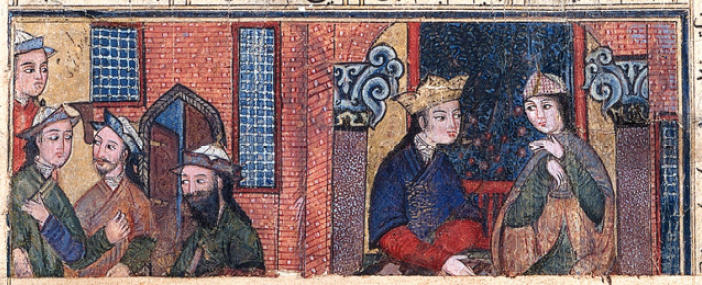Register a SNAP EBT card with Amazon

Create an Amazon Wedding Registry
Ilkhanid Illustration
Great Mongol (Demotte) Shāh-Nāmeh
Chapter 5 - Zahhak (1000 years)
Faridun questions his mother
Tabriz, Persia, c.1335AD

Fig. 182 – Detail of mutilated page from the Abu-Sa`id-nāma manuscript that alludes to Genghis Khan’s first son as being a bastard
Two centuries later, after the Mongols had taken northern China from the Chin, and southern China from the Song, and when they had pushed their conquests to the shores of the Mediterranean Sea, their empire began to disintegrate as various Mongol princes vied to carve independent kingdoms within their fiefdoms. Like the Dukes of Burgundy who were French but ruled over Netherlandish and Germanic territories, these Mongol princes ruled in foreign lands while remaining entrenched in their own nomadic culture. In Iran, however, the process of acculturation of the ruling Mongol dynasty had begun early on, and it reached a culminating point with the reign of Abu-Sa`id Bahādor Khan (r. 1317-35), who was a noted littérateur, a calligrapher, and a patron of fine arts.
A major element in the education process of the young Abu-Sa`id was the production of an illustrated copy of the great Persian epic compendium, the Shāhnāma or Book of Kings, in which every painting was meant to illustrate both a story of the Shāhnāma and an event of Mongol history. It was nicknamed Abu-Sa`id-nāma, literally meaning the Book of Abu-Sa`id, which implicitly placed Abu-Sa`id among the epic kings of Iran.242 Interestingly, the Shāhnāma incorporated a large section of the history of Alexander, not the one based on Quintus Curtius’ text but the more picturesque version attributed to the pseudo-Callisthenes author. The fantastic stories of Alexander were useful elements in the task of attracting the young Mongol prince’s attention toward Persian poetry, and at the same time, like the History of Alexander the Great that was translated for Charles the Bold by Vasco da Lucena, it was of the Mirror-for-Princes genre and could educate him in the virtues of justice and good government. It also served to poke fun at rival cousins and settle scores with them. Whereas The Execution of Philotas (fig. 123) was a reminder of Louis XI’s treachery toward Charles the Bold and the Liège inhabitants, a scene from the Abu-Sa`id-nāma was used to denigrate Abu-Sa`id’s cousins, the Khans of the Golden Horde who ruled in Russia, by reminding them that, as descendants of Genghis’ first “son” Jochi (1185–1226), who had been conceived while Genghis’ wife had been abducted by a rival tribe (fig. 182), they were not real progenies of Genghis but descendants of a bastard.243 The Khans of the Golden Horde had always considered the kingdom of Iran as part of their fiefdom and Abu-Sa`id and his forefathers as usurpers. To counter that claim, Abu-Sa`id used this illustration of his Abu-Sa`id-nāma to publicize a family secret (that Jochi was a bastard), which official Mongol histories of Iran and China had suppressed. Had it not been for the fortuitous survival of a unique copy of the Secret History of the Mongols written in the Mongolian language but in Chinese characters, this illustration would have been our only pointer to the problematic genealogy of the Golden Horde.
242 Soudavar 1996. The Abu-Sa`id-nāma is generally referred to as the Demotte Shāhnāma in Western publications, with Demotte being the Parisian dealer most responsible for the dispersal of the pages of this once complete manuscript.
243 In the right section of this badly mutilated illustration, the young hero Fereydun, who was destined to rule the world but was hidden at birth from the wrath of a tyrant, questions his mother about the identity of his father. This questioning is then equated on the left part with the brawl that occurred between Genghis’ sons, when the latter was about to name his successor. They questioned Jochi’s right to rule because he was not Genghis’ true son. At the end, Genghis nominates his third son as his successor and asks the others to swear allegiance to him, an act that is illustrated on the right [left] as his remaining sons put their fists on their hearts.
Fig. 123 The Execution of Philotas and his Father, detail of fol. 149 of the History of Alexander the Great, The J. Paul Getty Museum, Los Angeles, 83.MR.178.149, leaf: 43.2 x 33 cm, image: courtesy of the Getty.
Fig. 182 A page from the Abu-Sa`id-nāma manuscript, Art and History Collection, Arthur M. Sackler Gallery, Washington DC LTS1995.2.13 (Photo by A. Soudavar)
Source: pp. 128-130, Decoding Old Masters Patrons, Princes and Enigmatic Paintings of the 15th Century by Abolala Soudavar, 2008
Title of Work: Shahnama (Great Mongol)
Scene: Faridun questions his mother
English Title: Faridun Asking For His Lineage
Dimensions (h x w): 140 x 200 mm or 192 x 71 mm
Format: Rectangular within borders
Reconstructed Folio: 006r
Gregorian Date: 1335 (circa)
School: Tabriz
Colnaghi Auction House, London, 1976
On Loan To Sackler Gallery LTS1995.2.13, lent by Art and History Collection
Source: Shahnama Project
Previous: f. 005r: 'The Iranians place the Arab king Zahhak on the throne'. Great Mongol (Demotte) Shahnama. Tabriz, Persia. Ilkhanid. Freer Gallery of Art, Washington, F1923.5.
Next: f. 007r: 'Faridun defeats Zahhak', Great Mongol (Demotte) Shāh-Nāmeh, Tabriz, c.1335 - Ilkhanid Soldiers. Museum of Islamic Art, Doha, Qatar, MS 200.
Back to the Great Mongol (Demotte) Shah-Nameh. Tabriz, Ilkhanid Persia.


